Advanced Financial Accounting Assignment: Tutt Bryant Group Analysis
VerifiedAdded on 2020/05/16
|17
|2908
|51
Report
AI Summary
This report provides a comprehensive analysis of the 2010 financial statements of Tutt Bryant Group Limited, focusing on impairment disclosures and accounting practices. The report examines the company's approach to impairment testing, including the methods used, such as amortized cost and fair value, and the various internal and external factors considered. It also delves into the subjectivity involved in management's estimates and assumptions, particularly concerning intangible assets and the application of IAS 36. Furthermore, the report compares the old and new leasing standards, highlighting how the new standard addresses the shortcomings of the previous one by increasing transparency and providing a more accurate reflection of a company's liabilities, especially regarding operating leases. The analysis also discusses the benefits of the new standard for investors and the impact on financial statement comparability.

Secure Best Marks with AI Grader
Need help grading? Try our AI Grader for instant feedback on your assignments.
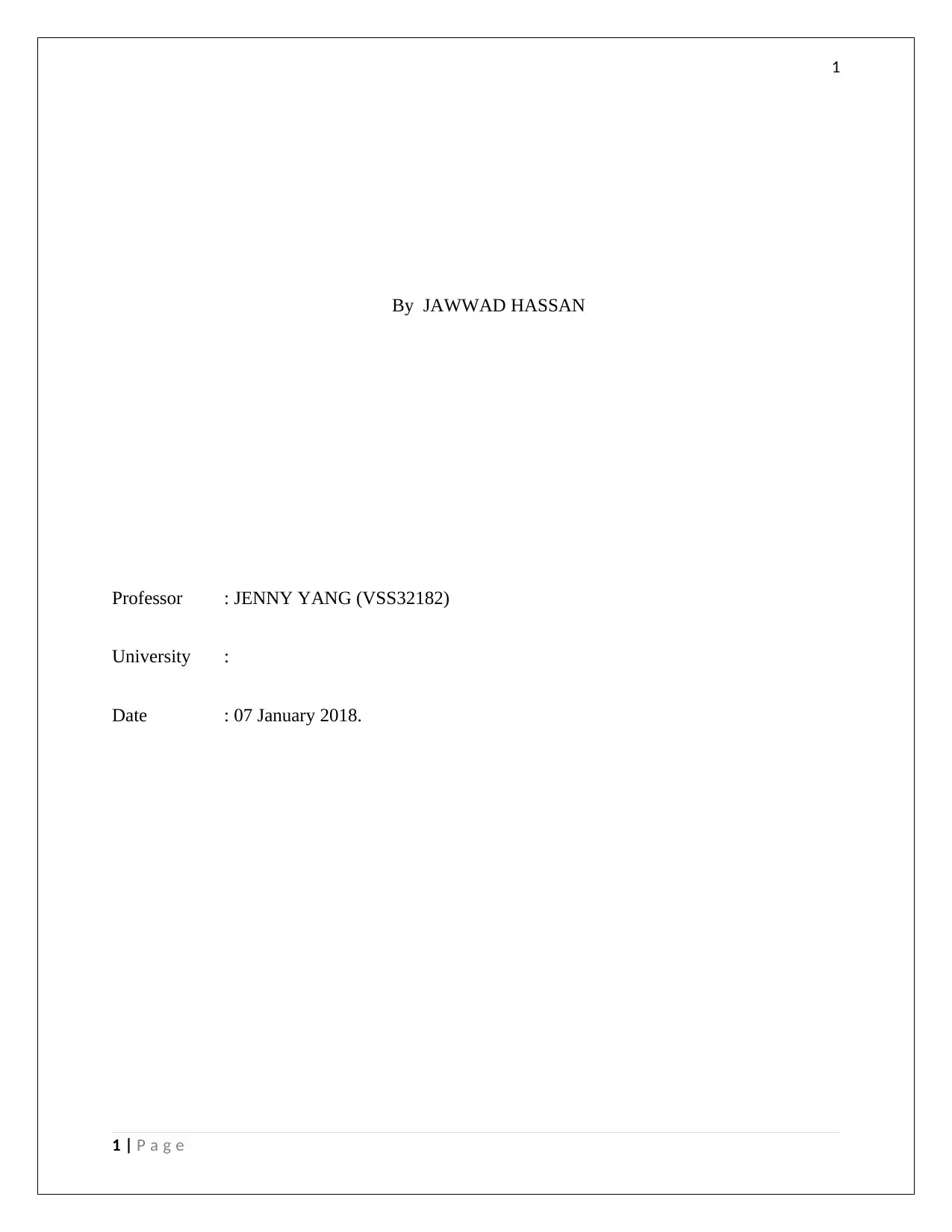
1
By JAWWAD HASSAN
Professor : JENNY YANG (VSS32182)
University :
Date : 07 January 2018.
1 | P a g e
By JAWWAD HASSAN
Professor : JENNY YANG (VSS32182)
University :
Date : 07 January 2018.
1 | P a g e
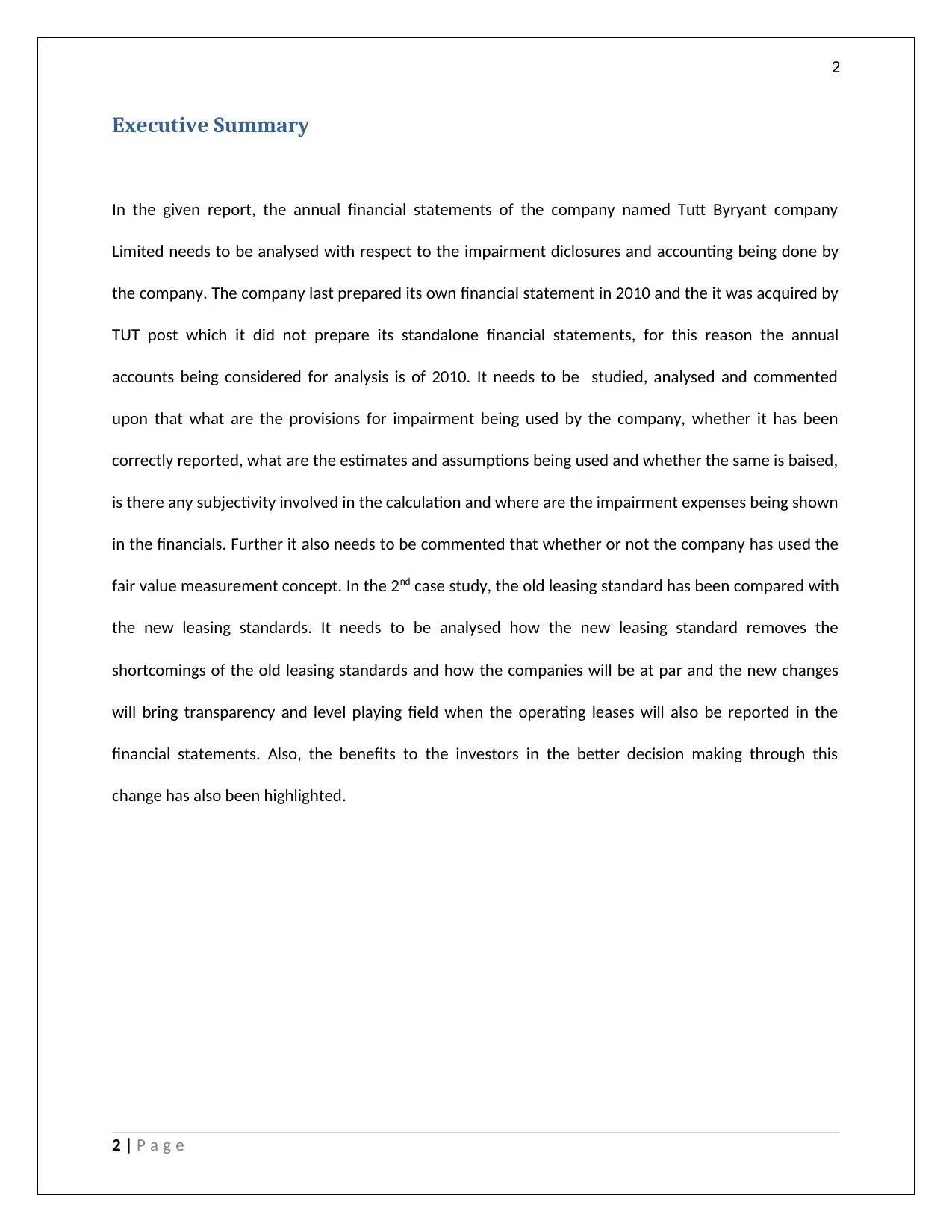
2
Executive Summary
In the given report, the annual financial statements of the company named Tutt Byryant company
Limited needs to be analysed with respect to the impairment diclosures and accounting being done by
the company. The company last prepared its own financial statement in 2010 and the it was acquired by
TUT post which it did not prepare its standalone financial statements, for this reason the annual
accounts being considered for analysis is of 2010. It needs to be studied, analysed and commented
upon that what are the provisions for impairment being used by the company, whether it has been
correctly reported, what are the estimates and assumptions being used and whether the same is baised,
is there any subjectivity involved in the calculation and where are the impairment expenses being shown
in the financials. Further it also needs to be commented that whether or not the company has used the
fair value measurement concept. In the 2nd case study, the old leasing standard has been compared with
the new leasing standards. It needs to be analysed how the new leasing standard removes the
shortcomings of the old leasing standards and how the companies will be at par and the new changes
will bring transparency and level playing field when the operating leases will also be reported in the
financial statements. Also, the benefits to the investors in the better decision making through this
change has also been highlighted.
2 | P a g e
Executive Summary
In the given report, the annual financial statements of the company named Tutt Byryant company
Limited needs to be analysed with respect to the impairment diclosures and accounting being done by
the company. The company last prepared its own financial statement in 2010 and the it was acquired by
TUT post which it did not prepare its standalone financial statements, for this reason the annual
accounts being considered for analysis is of 2010. It needs to be studied, analysed and commented
upon that what are the provisions for impairment being used by the company, whether it has been
correctly reported, what are the estimates and assumptions being used and whether the same is baised,
is there any subjectivity involved in the calculation and where are the impairment expenses being shown
in the financials. Further it also needs to be commented that whether or not the company has used the
fair value measurement concept. In the 2nd case study, the old leasing standard has been compared with
the new leasing standards. It needs to be analysed how the new leasing standard removes the
shortcomings of the old leasing standards and how the companies will be at par and the new changes
will bring transparency and level playing field when the operating leases will also be reported in the
financial statements. Also, the benefits to the investors in the better decision making through this
change has also been highlighted.
2 | P a g e
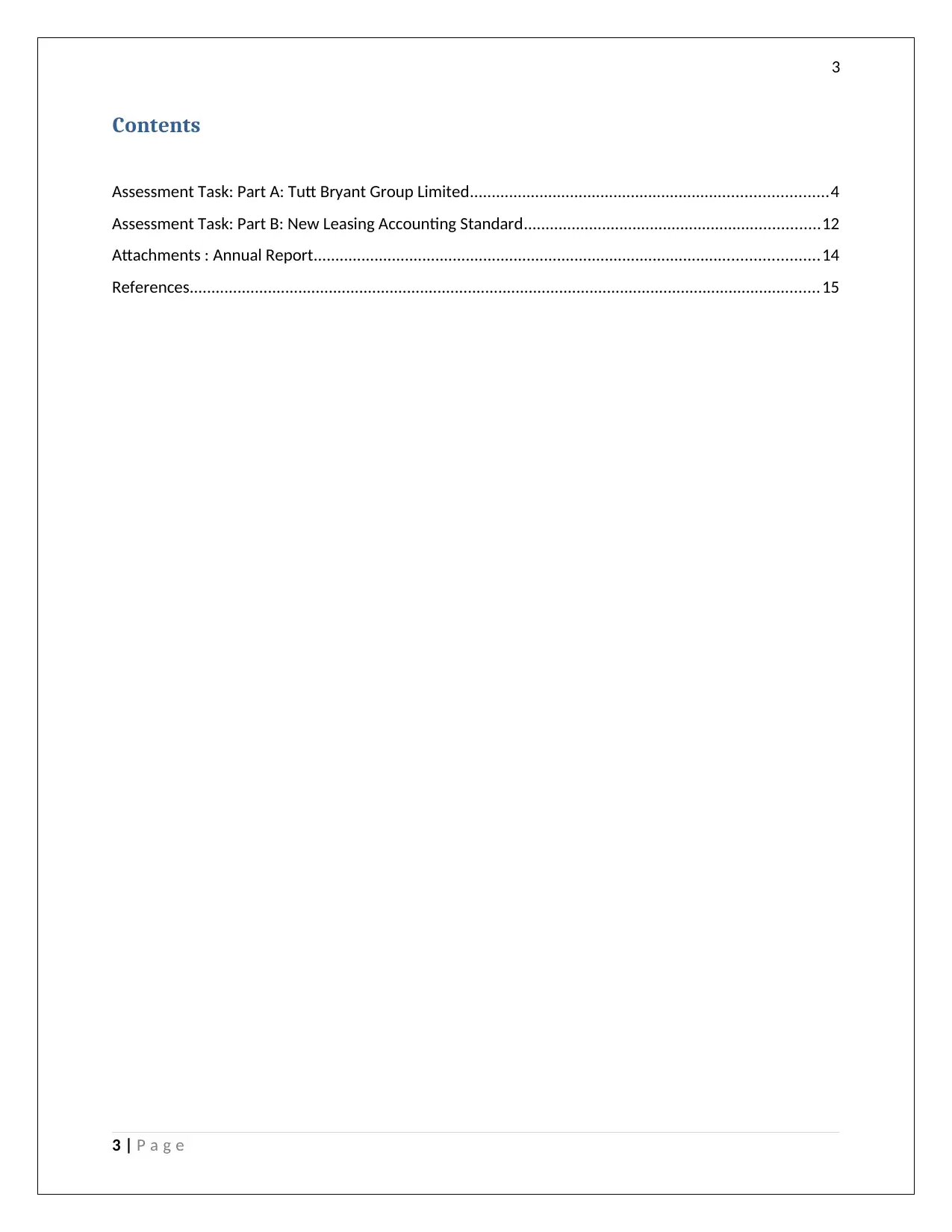
3
Contents
Assessment Task: Part A: Tutt Bryant Group Limited..................................................................................4
Assessment Task: Part B: New Leasing Accounting Standard....................................................................12
Attachments : Annual Report....................................................................................................................14
References.................................................................................................................................................15
3 | P a g e
Contents
Assessment Task: Part A: Tutt Bryant Group Limited..................................................................................4
Assessment Task: Part B: New Leasing Accounting Standard....................................................................12
Attachments : Annual Report....................................................................................................................14
References.................................................................................................................................................15
3 | P a g e
Secure Best Marks with AI Grader
Need help grading? Try our AI Grader for instant feedback on your assignments.
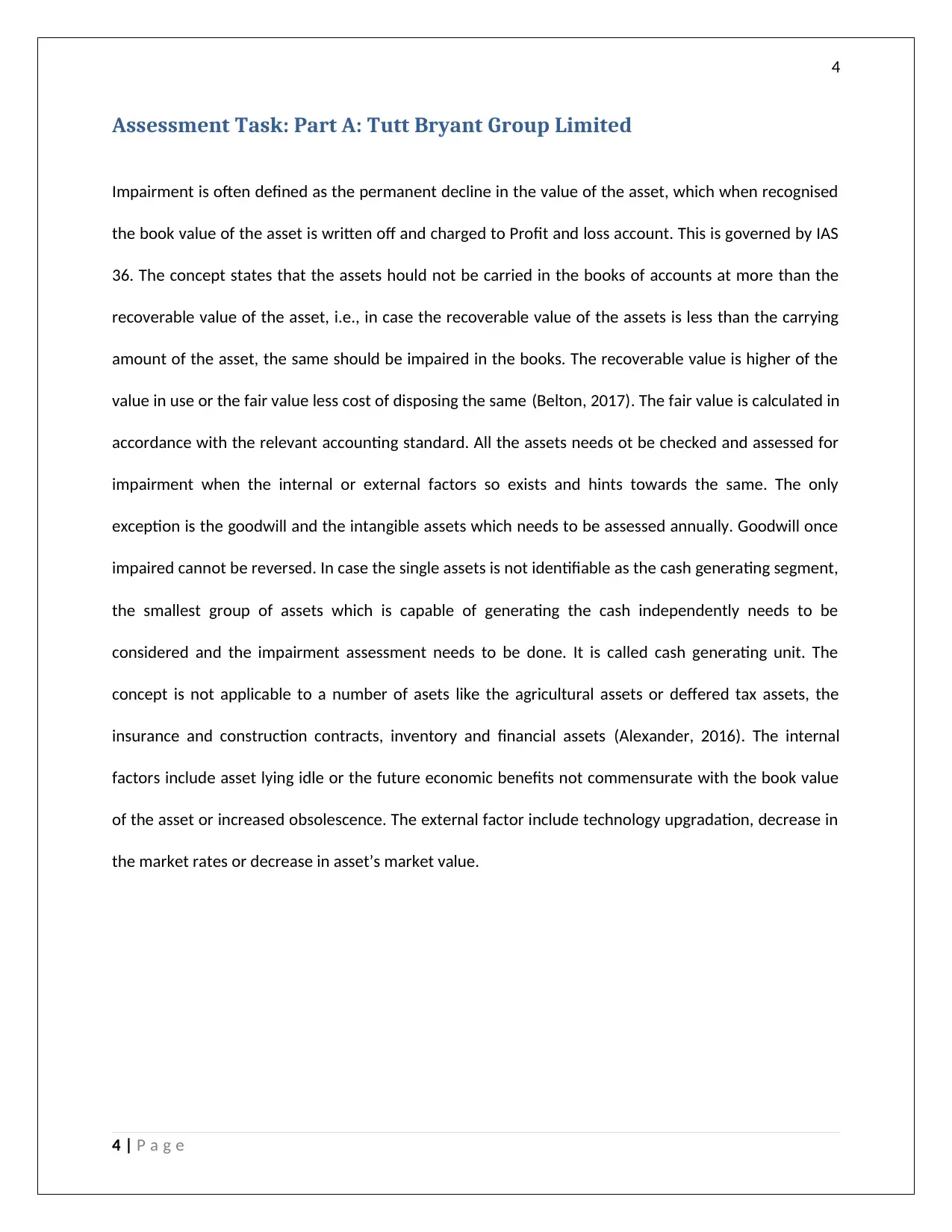
4
Assessment Task: Part A: Tutt Bryant Group Limited
Impairment is often defined as the permanent decline in the value of the asset, which when recognised
the book value of the asset is written off and charged to Profit and loss account. This is governed by IAS
36. The concept states that the assets hould not be carried in the books of accounts at more than the
recoverable value of the asset, i.e., in case the recoverable value of the assets is less than the carrying
amount of the asset, the same should be impaired in the books. The recoverable value is higher of the
value in use or the fair value less cost of disposing the same (Belton, 2017). The fair value is calculated in
accordance with the relevant accounting standard. All the assets needs ot be checked and assessed for
impairment when the internal or external factors so exists and hints towards the same. The only
exception is the goodwill and the intangible assets which needs to be assessed annually. Goodwill once
impaired cannot be reversed. In case the single assets is not identifiable as the cash generating segment,
the smallest group of assets which is capable of generating the cash independently needs to be
considered and the impairment assessment needs to be done. It is called cash generating unit. The
concept is not applicable to a number of asets like the agricultural assets or deffered tax assets, the
insurance and construction contracts, inventory and financial assets (Alexander, 2016). The internal
factors include asset lying idle or the future economic benefits not commensurate with the book value
of the asset or increased obsolescence. The external factor include technology upgradation, decrease in
the market rates or decrease in asset’s market value.
4 | P a g e
Assessment Task: Part A: Tutt Bryant Group Limited
Impairment is often defined as the permanent decline in the value of the asset, which when recognised
the book value of the asset is written off and charged to Profit and loss account. This is governed by IAS
36. The concept states that the assets hould not be carried in the books of accounts at more than the
recoverable value of the asset, i.e., in case the recoverable value of the assets is less than the carrying
amount of the asset, the same should be impaired in the books. The recoverable value is higher of the
value in use or the fair value less cost of disposing the same (Belton, 2017). The fair value is calculated in
accordance with the relevant accounting standard. All the assets needs ot be checked and assessed for
impairment when the internal or external factors so exists and hints towards the same. The only
exception is the goodwill and the intangible assets which needs to be assessed annually. Goodwill once
impaired cannot be reversed. In case the single assets is not identifiable as the cash generating segment,
the smallest group of assets which is capable of generating the cash independently needs to be
considered and the impairment assessment needs to be done. It is called cash generating unit. The
concept is not applicable to a number of asets like the agricultural assets or deffered tax assets, the
insurance and construction contracts, inventory and financial assets (Alexander, 2016). The internal
factors include asset lying idle or the future economic benefits not commensurate with the book value
of the asset or increased obsolescence. The external factor include technology upgradation, decrease in
the market rates or decrease in asset’s market value.
4 | P a g e
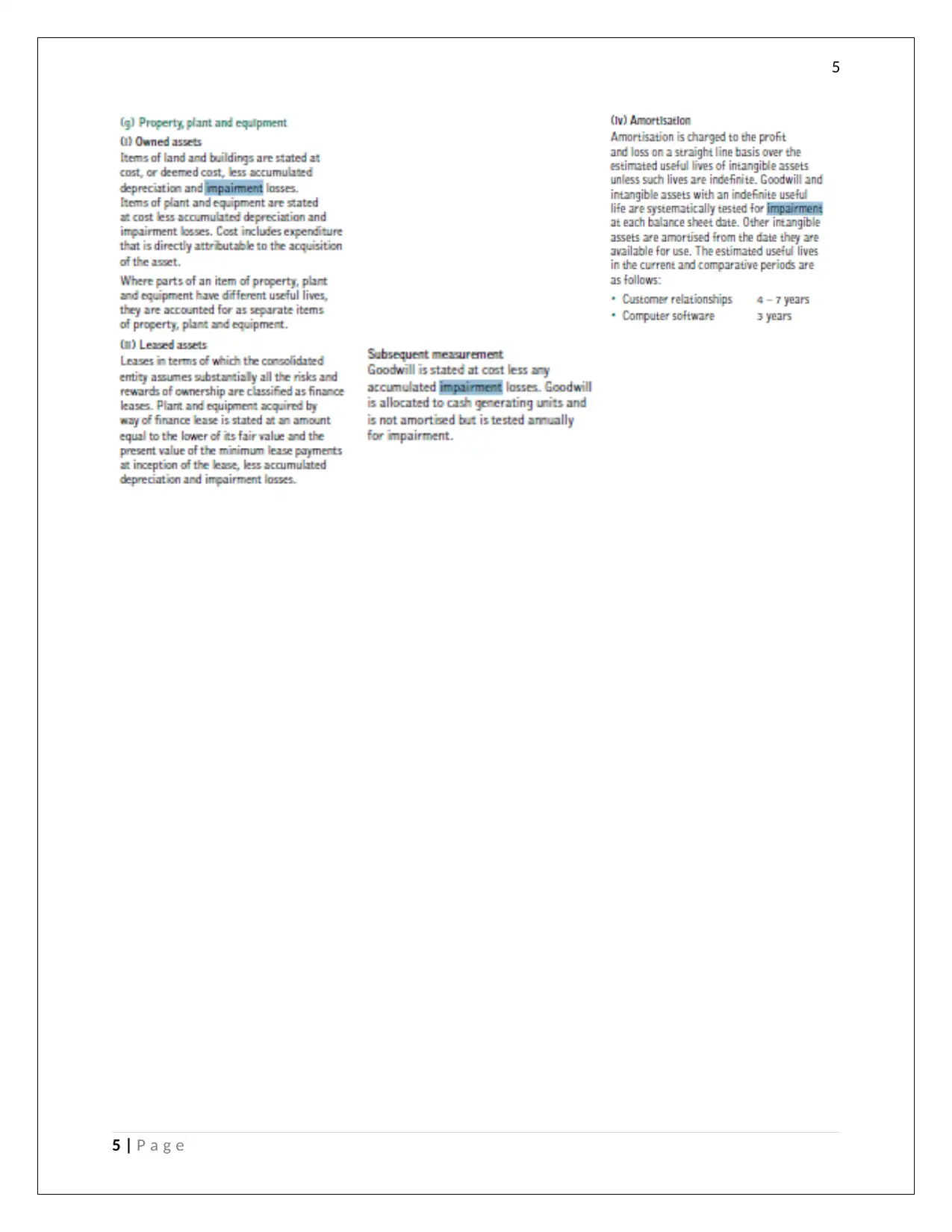
5
5 | P a g e
5 | P a g e
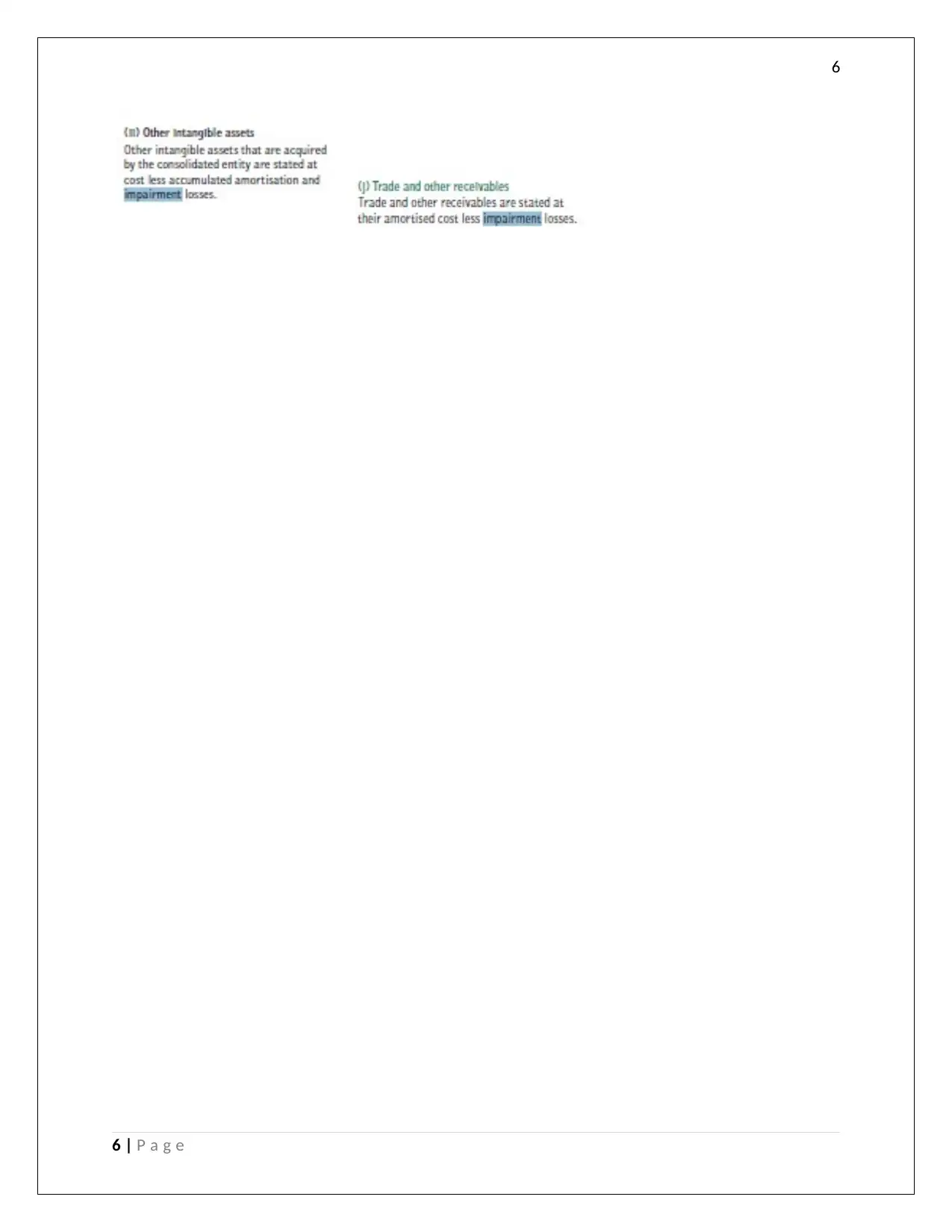
6
6 | P a g e
6 | P a g e
Paraphrase This Document
Need a fresh take? Get an instant paraphrase of this document with our AI Paraphraser
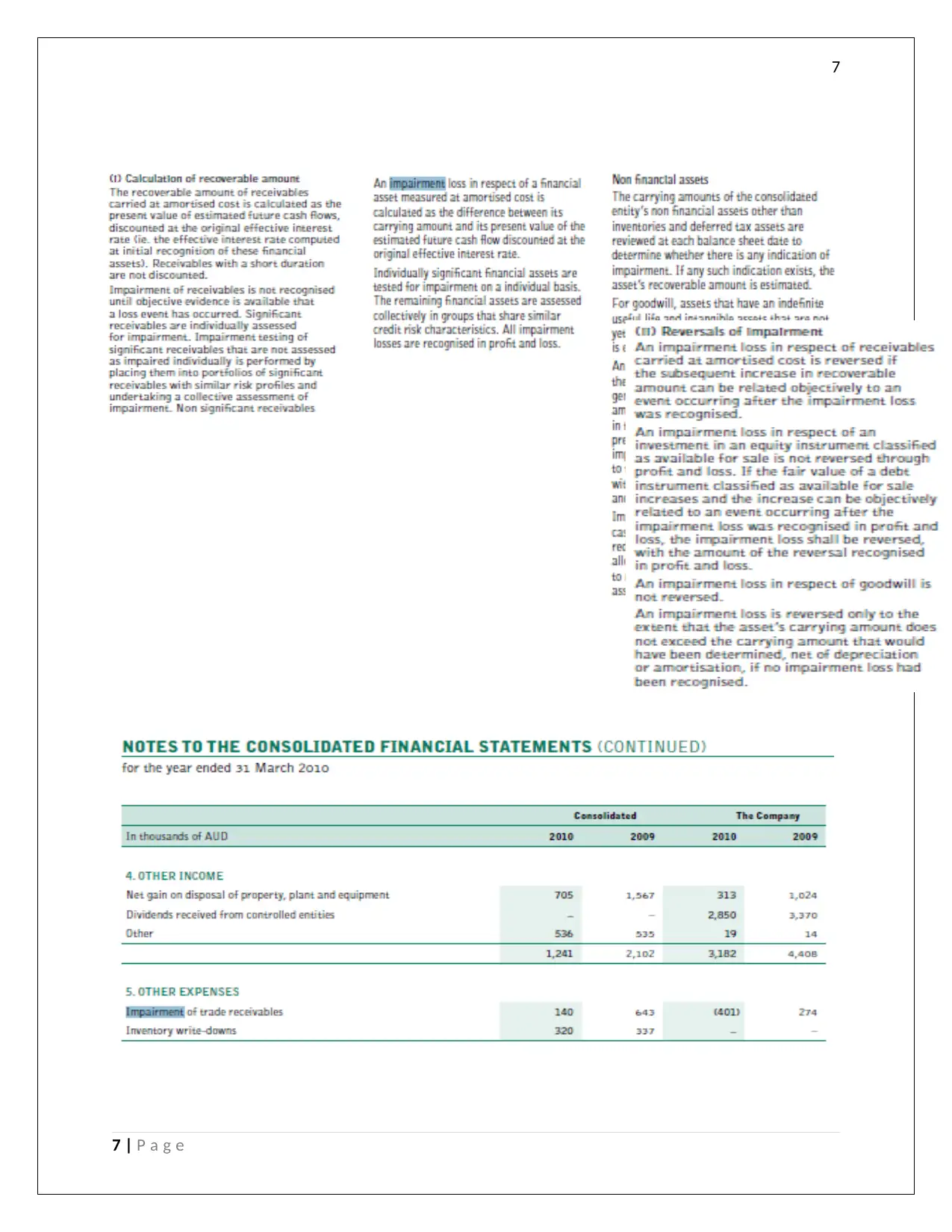
7
7 | P a g e
7 | P a g e
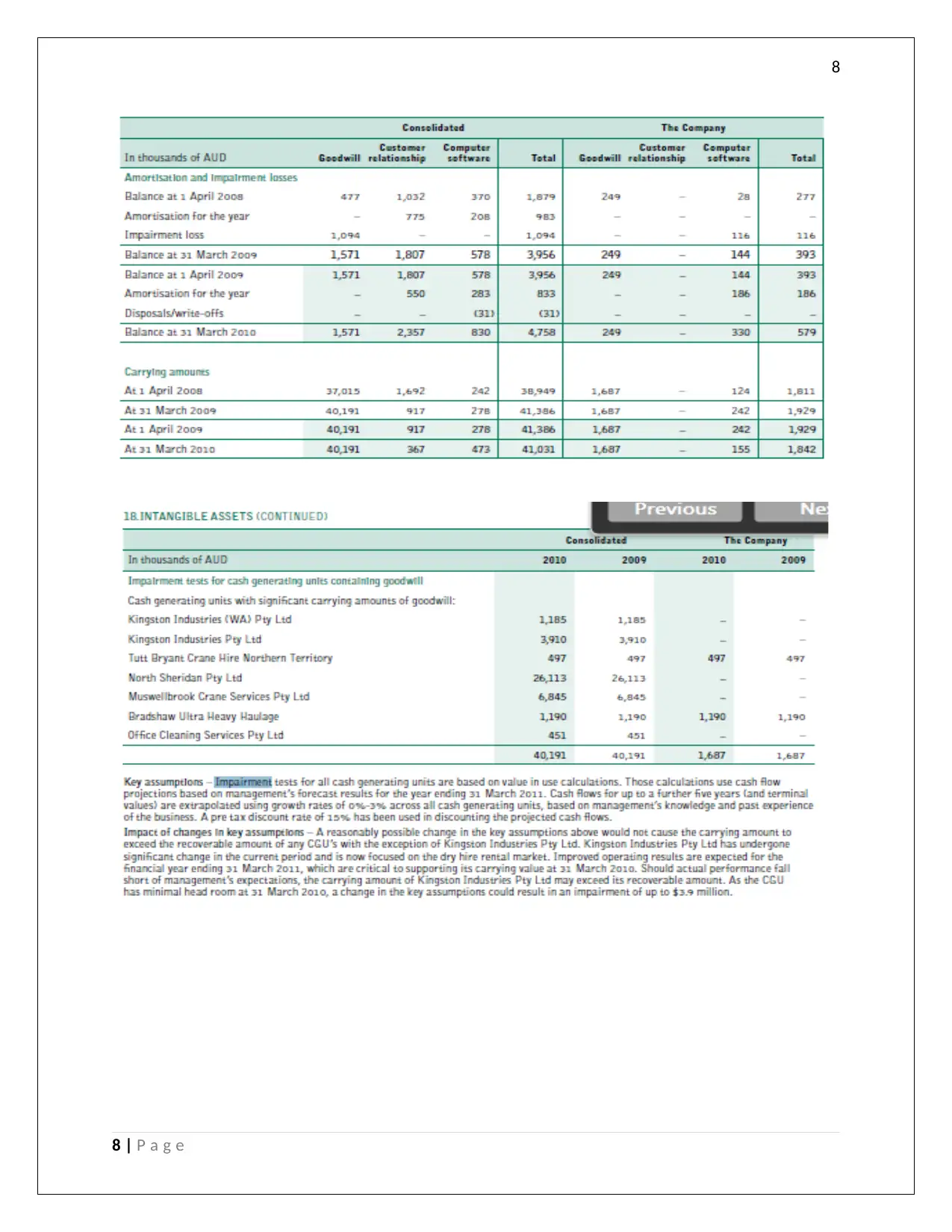
8
8 | P a g e
8 | P a g e
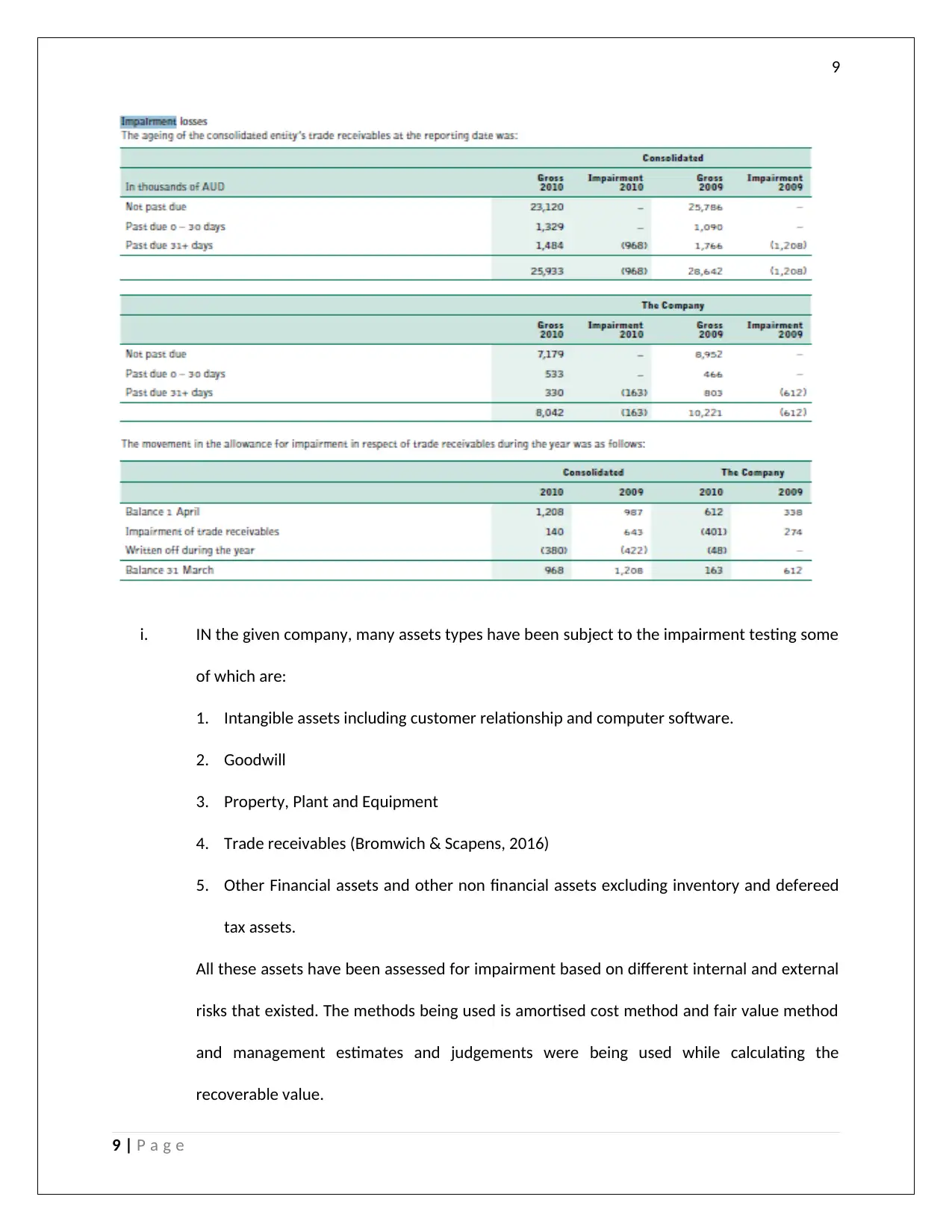
9
i. IN the given company, many assets types have been subject to the impairment testing some
of which are:
1. Intangible assets including customer relationship and computer software.
2. Goodwill
3. Property, Plant and Equipment
4. Trade receivables (Bromwich & Scapens, 2016)
5. Other Financial assets and other non financial assets excluding inventory and defereed
tax assets.
All these assets have been assessed for impairment based on different internal and external
risks that existed. The methods being used is amortised cost method and fair value method
and management estimates and judgements were being used while calculating the
recoverable value.
9 | P a g e
i. IN the given company, many assets types have been subject to the impairment testing some
of which are:
1. Intangible assets including customer relationship and computer software.
2. Goodwill
3. Property, Plant and Equipment
4. Trade receivables (Bromwich & Scapens, 2016)
5. Other Financial assets and other non financial assets excluding inventory and defereed
tax assets.
All these assets have been assessed for impairment based on different internal and external
risks that existed. The methods being used is amortised cost method and fair value method
and management estimates and judgements were being used while calculating the
recoverable value.
9 | P a g e
Secure Best Marks with AI Grader
Need help grading? Try our AI Grader for instant feedback on your assignments.
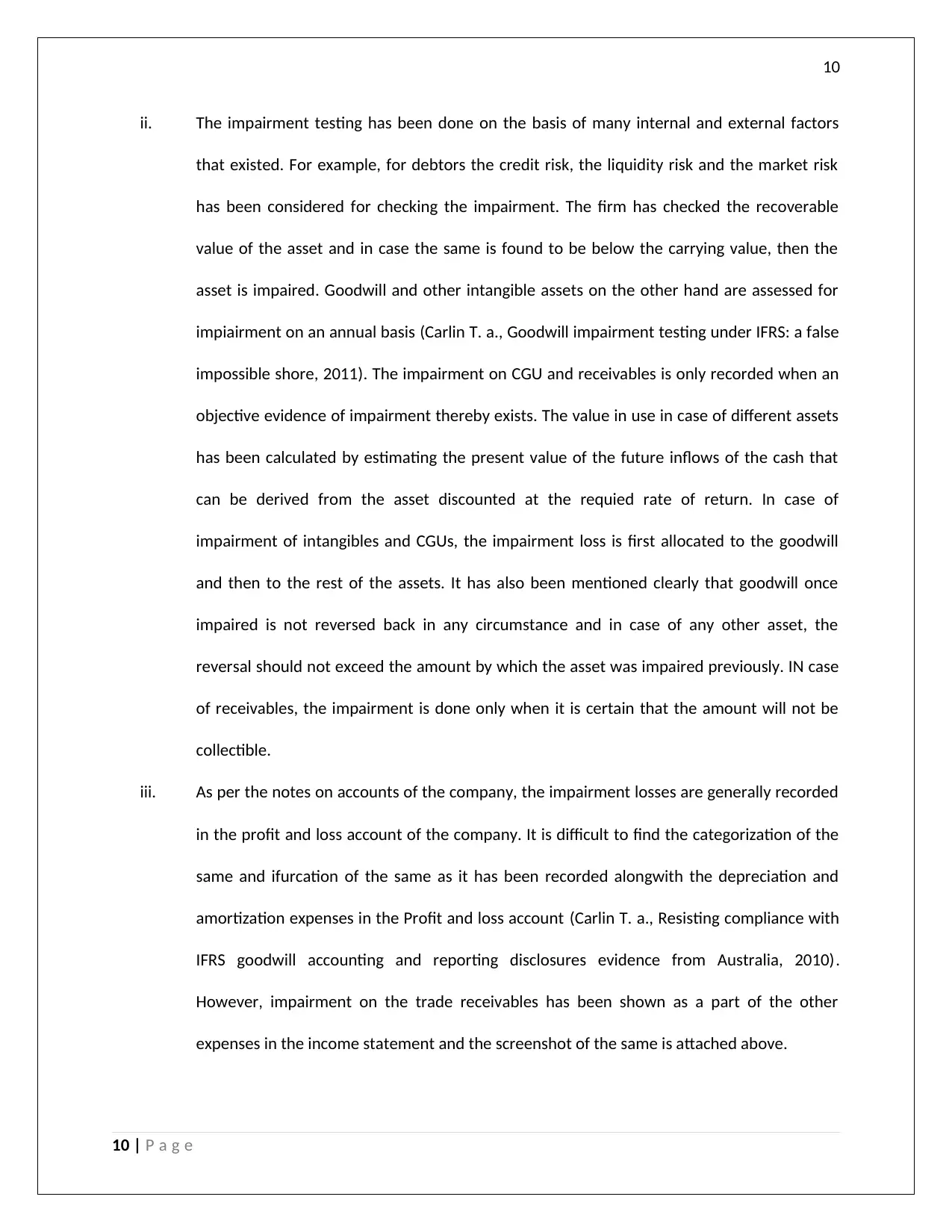
10
ii. The impairment testing has been done on the basis of many internal and external factors
that existed. For example, for debtors the credit risk, the liquidity risk and the market risk
has been considered for checking the impairment. The firm has checked the recoverable
value of the asset and in case the same is found to be below the carrying value, then the
asset is impaired. Goodwill and other intangible assets on the other hand are assessed for
impiairment on an annual basis (Carlin T. a., Goodwill impairment testing under IFRS: a false
impossible shore, 2011). The impairment on CGU and receivables is only recorded when an
objective evidence of impairment thereby exists. The value in use in case of different assets
has been calculated by estimating the present value of the future inflows of the cash that
can be derived from the asset discounted at the requied rate of return. In case of
impairment of intangibles and CGUs, the impairment loss is first allocated to the goodwill
and then to the rest of the assets. It has also been mentioned clearly that goodwill once
impaired is not reversed back in any circumstance and in case of any other asset, the
reversal should not exceed the amount by which the asset was impaired previously. IN case
of receivables, the impairment is done only when it is certain that the amount will not be
collectible.
iii. As per the notes on accounts of the company, the impairment losses are generally recorded
in the profit and loss account of the company. It is difficult to find the categorization of the
same and ifurcation of the same as it has been recorded alongwith the depreciation and
amortization expenses in the Profit and loss account (Carlin T. a., Resisting compliance with
IFRS goodwill accounting and reporting disclosures evidence from Australia, 2010).
However, impairment on the trade receivables has been shown as a part of the other
expenses in the income statement and the screenshot of the same is attached above.
10 | P a g e
ii. The impairment testing has been done on the basis of many internal and external factors
that existed. For example, for debtors the credit risk, the liquidity risk and the market risk
has been considered for checking the impairment. The firm has checked the recoverable
value of the asset and in case the same is found to be below the carrying value, then the
asset is impaired. Goodwill and other intangible assets on the other hand are assessed for
impiairment on an annual basis (Carlin T. a., Goodwill impairment testing under IFRS: a false
impossible shore, 2011). The impairment on CGU and receivables is only recorded when an
objective evidence of impairment thereby exists. The value in use in case of different assets
has been calculated by estimating the present value of the future inflows of the cash that
can be derived from the asset discounted at the requied rate of return. In case of
impairment of intangibles and CGUs, the impairment loss is first allocated to the goodwill
and then to the rest of the assets. It has also been mentioned clearly that goodwill once
impaired is not reversed back in any circumstance and in case of any other asset, the
reversal should not exceed the amount by which the asset was impaired previously. IN case
of receivables, the impairment is done only when it is certain that the amount will not be
collectible.
iii. As per the notes on accounts of the company, the impairment losses are generally recorded
in the profit and loss account of the company. It is difficult to find the categorization of the
same and ifurcation of the same as it has been recorded alongwith the depreciation and
amortization expenses in the Profit and loss account (Carlin T. a., Resisting compliance with
IFRS goodwill accounting and reporting disclosures evidence from Australia, 2010).
However, impairment on the trade receivables has been shown as a part of the other
expenses in the income statement and the screenshot of the same is attached above.
10 | P a g e
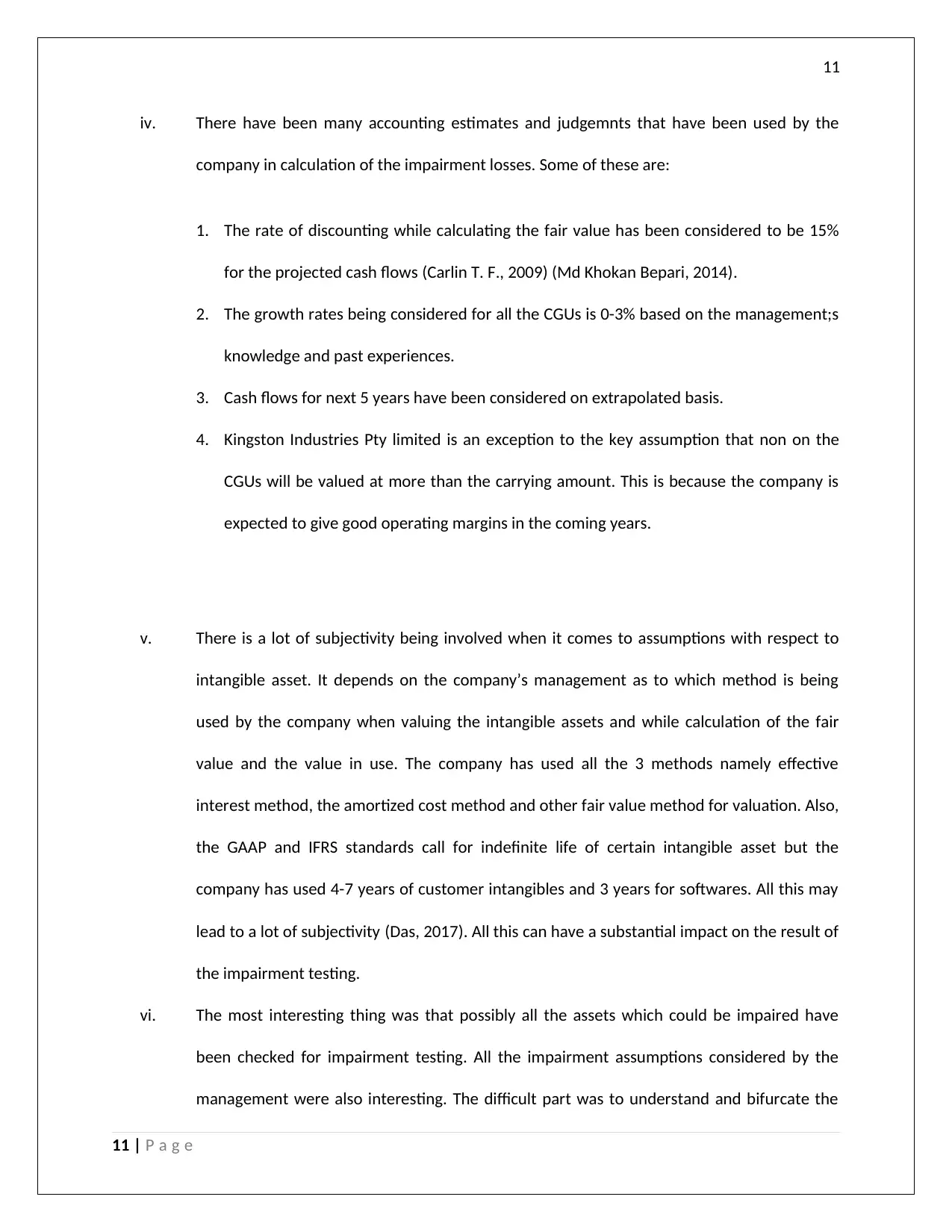
11
iv. There have been many accounting estimates and judgemnts that have been used by the
company in calculation of the impairment losses. Some of these are:
1. The rate of discounting while calculating the fair value has been considered to be 15%
for the projected cash flows (Carlin T. F., 2009) (Md Khokan Bepari, 2014).
2. The growth rates being considered for all the CGUs is 0-3% based on the management;s
knowledge and past experiences.
3. Cash flows for next 5 years have been considered on extrapolated basis.
4. Kingston Industries Pty limited is an exception to the key assumption that non on the
CGUs will be valued at more than the carrying amount. This is because the company is
expected to give good operating margins in the coming years.
v. There is a lot of subjectivity being involved when it comes to assumptions with respect to
intangible asset. It depends on the company’s management as to which method is being
used by the company when valuing the intangible assets and while calculation of the fair
value and the value in use. The company has used all the 3 methods namely effective
interest method, the amortized cost method and other fair value method for valuation. Also,
the GAAP and IFRS standards call for indefinite life of certain intangible asset but the
company has used 4-7 years of customer intangibles and 3 years for softwares. All this may
lead to a lot of subjectivity (Das, 2017). All this can have a substantial impact on the result of
the impairment testing.
vi. The most interesting thing was that possibly all the assets which could be impaired have
been checked for impairment testing. All the impairment assumptions considered by the
management were also interesting. The difficult part was to understand and bifurcate the
11 | P a g e
iv. There have been many accounting estimates and judgemnts that have been used by the
company in calculation of the impairment losses. Some of these are:
1. The rate of discounting while calculating the fair value has been considered to be 15%
for the projected cash flows (Carlin T. F., 2009) (Md Khokan Bepari, 2014).
2. The growth rates being considered for all the CGUs is 0-3% based on the management;s
knowledge and past experiences.
3. Cash flows for next 5 years have been considered on extrapolated basis.
4. Kingston Industries Pty limited is an exception to the key assumption that non on the
CGUs will be valued at more than the carrying amount. This is because the company is
expected to give good operating margins in the coming years.
v. There is a lot of subjectivity being involved when it comes to assumptions with respect to
intangible asset. It depends on the company’s management as to which method is being
used by the company when valuing the intangible assets and while calculation of the fair
value and the value in use. The company has used all the 3 methods namely effective
interest method, the amortized cost method and other fair value method for valuation. Also,
the GAAP and IFRS standards call for indefinite life of certain intangible asset but the
company has used 4-7 years of customer intangibles and 3 years for softwares. All this may
lead to a lot of subjectivity (Das, 2017). All this can have a substantial impact on the result of
the impairment testing.
vi. The most interesting thing was that possibly all the assets which could be impaired have
been checked for impairment testing. All the impairment assumptions considered by the
management were also interesting. The difficult part was to understand and bifurcate the
11 | P a g e
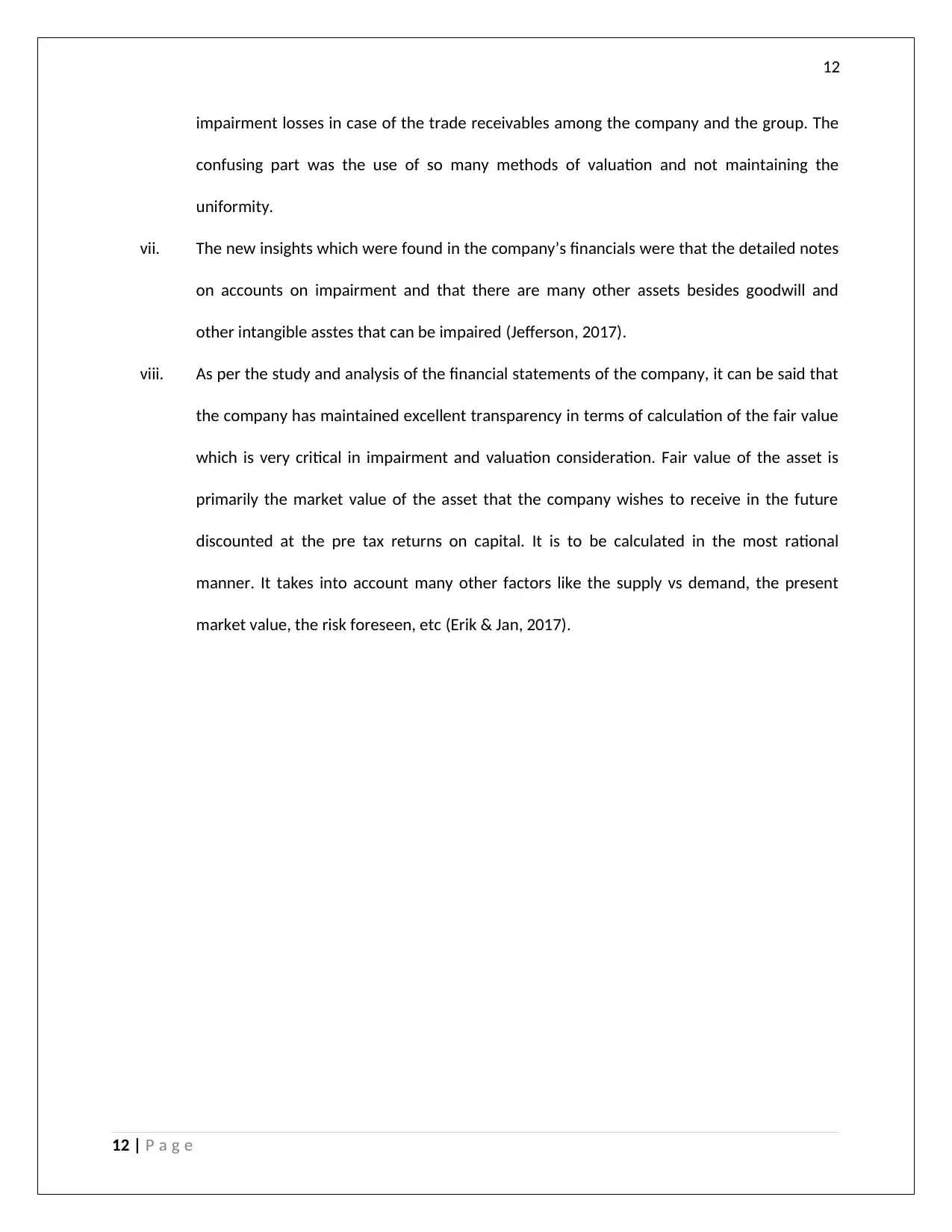
12
impairment losses in case of the trade receivables among the company and the group. The
confusing part was the use of so many methods of valuation and not maintaining the
uniformity.
vii. The new insights which were found in the company’s financials were that the detailed notes
on accounts on impairment and that there are many other assets besides goodwill and
other intangible asstes that can be impaired (Jefferson, 2017).
viii. As per the study and analysis of the financial statements of the company, it can be said that
the company has maintained excellent transparency in terms of calculation of the fair value
which is very critical in impairment and valuation consideration. Fair value of the asset is
primarily the market value of the asset that the company wishes to receive in the future
discounted at the pre tax returns on capital. It is to be calculated in the most rational
manner. It takes into account many other factors like the supply vs demand, the present
market value, the risk foreseen, etc (Erik & Jan, 2017).
12 | P a g e
impairment losses in case of the trade receivables among the company and the group. The
confusing part was the use of so many methods of valuation and not maintaining the
uniformity.
vii. The new insights which were found in the company’s financials were that the detailed notes
on accounts on impairment and that there are many other assets besides goodwill and
other intangible asstes that can be impaired (Jefferson, 2017).
viii. As per the study and analysis of the financial statements of the company, it can be said that
the company has maintained excellent transparency in terms of calculation of the fair value
which is very critical in impairment and valuation consideration. Fair value of the asset is
primarily the market value of the asset that the company wishes to receive in the future
discounted at the pre tax returns on capital. It is to be calculated in the most rational
manner. It takes into account many other factors like the supply vs demand, the present
market value, the risk foreseen, etc (Erik & Jan, 2017).
12 | P a g e
Paraphrase This Document
Need a fresh take? Get an instant paraphrase of this document with our AI Paraphraser
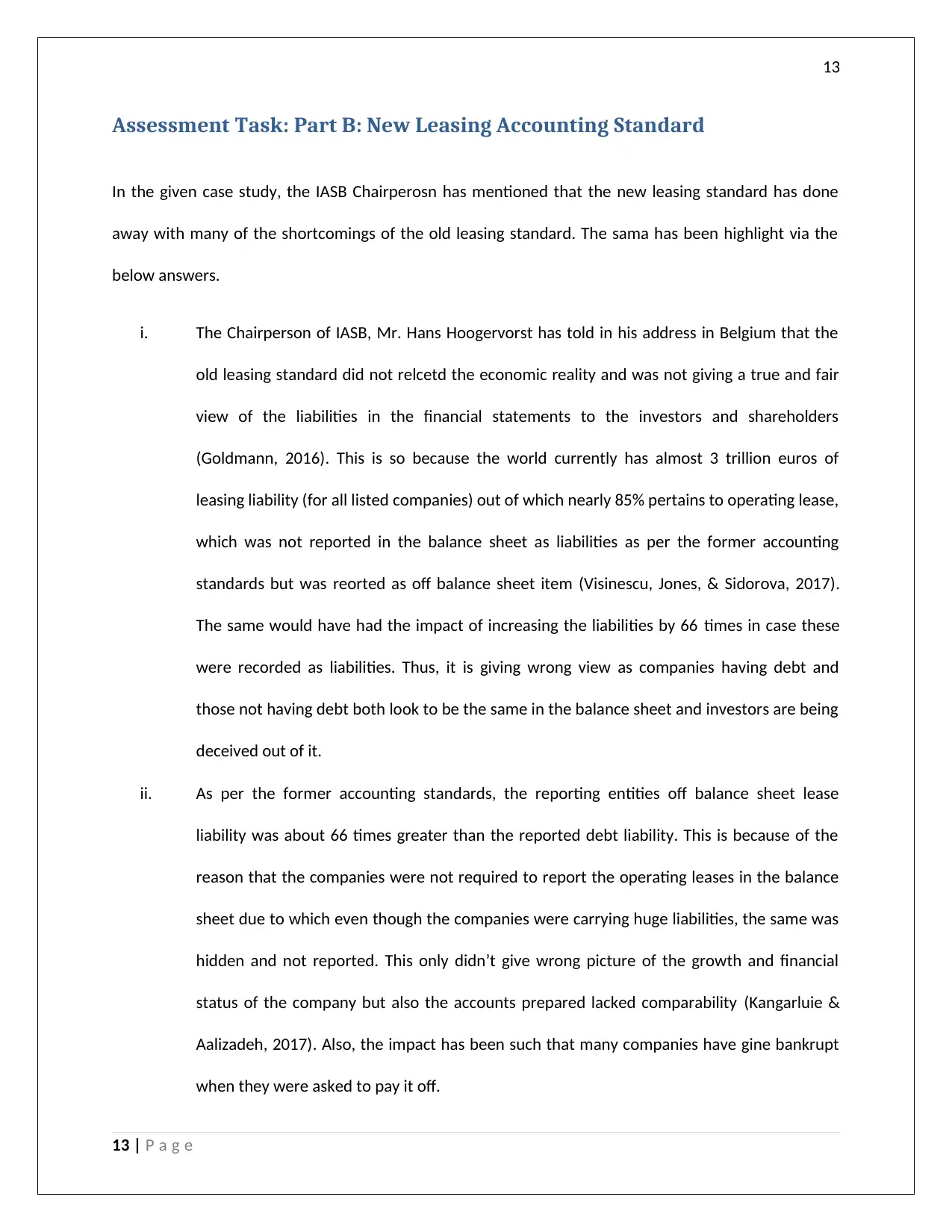
13
Assessment Task: Part B: New Leasing Accounting Standard
In the given case study, the IASB Chairperosn has mentioned that the new leasing standard has done
away with many of the shortcomings of the old leasing standard. The sama has been highlight via the
below answers.
i. The Chairperson of IASB, Mr. Hans Hoogervorst has told in his address in Belgium that the
old leasing standard did not relcetd the economic reality and was not giving a true and fair
view of the liabilities in the financial statements to the investors and shareholders
(Goldmann, 2016). This is so because the world currently has almost 3 trillion euros of
leasing liability (for all listed companies) out of which nearly 85% pertains to operating lease,
which was not reported in the balance sheet as liabilities as per the former accounting
standards but was reorted as off balance sheet item (Visinescu, Jones, & Sidorova, 2017).
The same would have had the impact of increasing the liabilities by 66 times in case these
were recorded as liabilities. Thus, it is giving wrong view as companies having debt and
those not having debt both look to be the same in the balance sheet and investors are being
deceived out of it.
ii. As per the former accounting standards, the reporting entities off balance sheet lease
liability was about 66 times greater than the reported debt liability. This is because of the
reason that the companies were not required to report the operating leases in the balance
sheet due to which even though the companies were carrying huge liabilities, the same was
hidden and not reported. This only didn’t give wrong picture of the growth and financial
status of the company but also the accounts prepared lacked comparability (Kangarluie &
Aalizadeh, 2017). Also, the impact has been such that many companies have gine bankrupt
when they were asked to pay it off.
13 | P a g e
Assessment Task: Part B: New Leasing Accounting Standard
In the given case study, the IASB Chairperosn has mentioned that the new leasing standard has done
away with many of the shortcomings of the old leasing standard. The sama has been highlight via the
below answers.
i. The Chairperson of IASB, Mr. Hans Hoogervorst has told in his address in Belgium that the
old leasing standard did not relcetd the economic reality and was not giving a true and fair
view of the liabilities in the financial statements to the investors and shareholders
(Goldmann, 2016). This is so because the world currently has almost 3 trillion euros of
leasing liability (for all listed companies) out of which nearly 85% pertains to operating lease,
which was not reported in the balance sheet as liabilities as per the former accounting
standards but was reorted as off balance sheet item (Visinescu, Jones, & Sidorova, 2017).
The same would have had the impact of increasing the liabilities by 66 times in case these
were recorded as liabilities. Thus, it is giving wrong view as companies having debt and
those not having debt both look to be the same in the balance sheet and investors are being
deceived out of it.
ii. As per the former accounting standards, the reporting entities off balance sheet lease
liability was about 66 times greater than the reported debt liability. This is because of the
reason that the companies were not required to report the operating leases in the balance
sheet due to which even though the companies were carrying huge liabilities, the same was
hidden and not reported. This only didn’t give wrong picture of the growth and financial
status of the company but also the accounts prepared lacked comparability (Kangarluie &
Aalizadeh, 2017). Also, the impact has been such that many companies have gine bankrupt
when they were asked to pay it off.
13 | P a g e
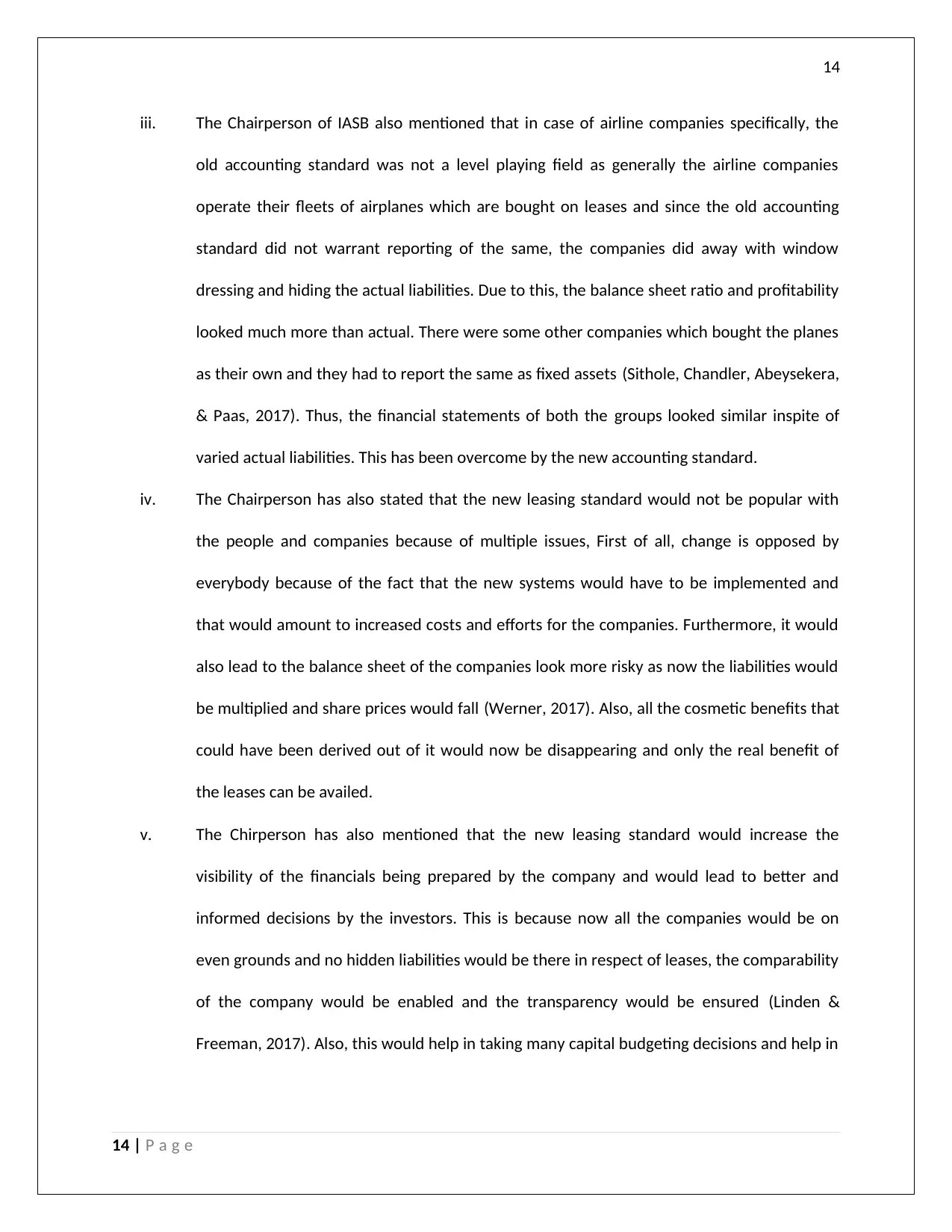
14
iii. The Chairperson of IASB also mentioned that in case of airline companies specifically, the
old accounting standard was not a level playing field as generally the airline companies
operate their fleets of airplanes which are bought on leases and since the old accounting
standard did not warrant reporting of the same, the companies did away with window
dressing and hiding the actual liabilities. Due to this, the balance sheet ratio and profitability
looked much more than actual. There were some other companies which bought the planes
as their own and they had to report the same as fixed assets (Sithole, Chandler, Abeysekera,
& Paas, 2017). Thus, the financial statements of both the groups looked similar inspite of
varied actual liabilities. This has been overcome by the new accounting standard.
iv. The Chairperson has also stated that the new leasing standard would not be popular with
the people and companies because of multiple issues, First of all, change is opposed by
everybody because of the fact that the new systems would have to be implemented and
that would amount to increased costs and efforts for the companies. Furthermore, it would
also lead to the balance sheet of the companies look more risky as now the liabilities would
be multiplied and share prices would fall (Werner, 2017). Also, all the cosmetic benefits that
could have been derived out of it would now be disappearing and only the real benefit of
the leases can be availed.
v. The Chirperson has also mentioned that the new leasing standard would increase the
visibility of the financials being prepared by the company and would lead to better and
informed decisions by the investors. This is because now all the companies would be on
even grounds and no hidden liabilities would be there in respect of leases, the comparability
of the company would be enabled and the transparency would be ensured (Linden &
Freeman, 2017). Also, this would help in taking many capital budgeting decisions and help in
14 | P a g e
iii. The Chairperson of IASB also mentioned that in case of airline companies specifically, the
old accounting standard was not a level playing field as generally the airline companies
operate their fleets of airplanes which are bought on leases and since the old accounting
standard did not warrant reporting of the same, the companies did away with window
dressing and hiding the actual liabilities. Due to this, the balance sheet ratio and profitability
looked much more than actual. There were some other companies which bought the planes
as their own and they had to report the same as fixed assets (Sithole, Chandler, Abeysekera,
& Paas, 2017). Thus, the financial statements of both the groups looked similar inspite of
varied actual liabilities. This has been overcome by the new accounting standard.
iv. The Chairperson has also stated that the new leasing standard would not be popular with
the people and companies because of multiple issues, First of all, change is opposed by
everybody because of the fact that the new systems would have to be implemented and
that would amount to increased costs and efforts for the companies. Furthermore, it would
also lead to the balance sheet of the companies look more risky as now the liabilities would
be multiplied and share prices would fall (Werner, 2017). Also, all the cosmetic benefits that
could have been derived out of it would now be disappearing and only the real benefit of
the leases can be availed.
v. The Chirperson has also mentioned that the new leasing standard would increase the
visibility of the financials being prepared by the company and would lead to better and
informed decisions by the investors. This is because now all the companies would be on
even grounds and no hidden liabilities would be there in respect of leases, the comparability
of the company would be enabled and the transparency would be ensured (Linden &
Freeman, 2017). Also, this would help in taking many capital budgeting decisions and help in
14 | P a g e
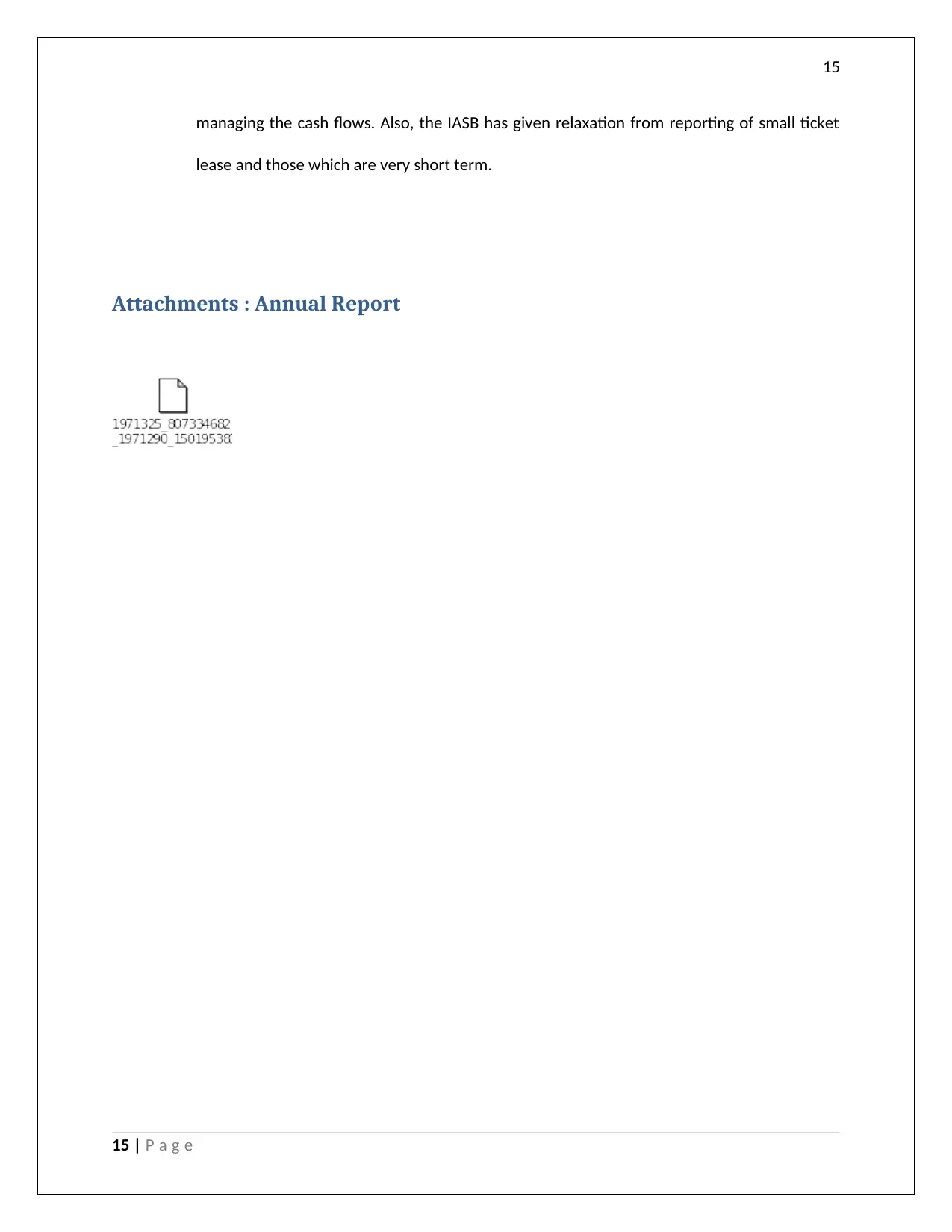
15
managing the cash flows. Also, the IASB has given relaxation from reporting of small ticket
lease and those which are very short term.
Attachments : Annual Report
15 | P a g e
managing the cash flows. Also, the IASB has given relaxation from reporting of small ticket
lease and those which are very short term.
Attachments : Annual Report
15 | P a g e
Secure Best Marks with AI Grader
Need help grading? Try our AI Grader for instant feedback on your assignments.
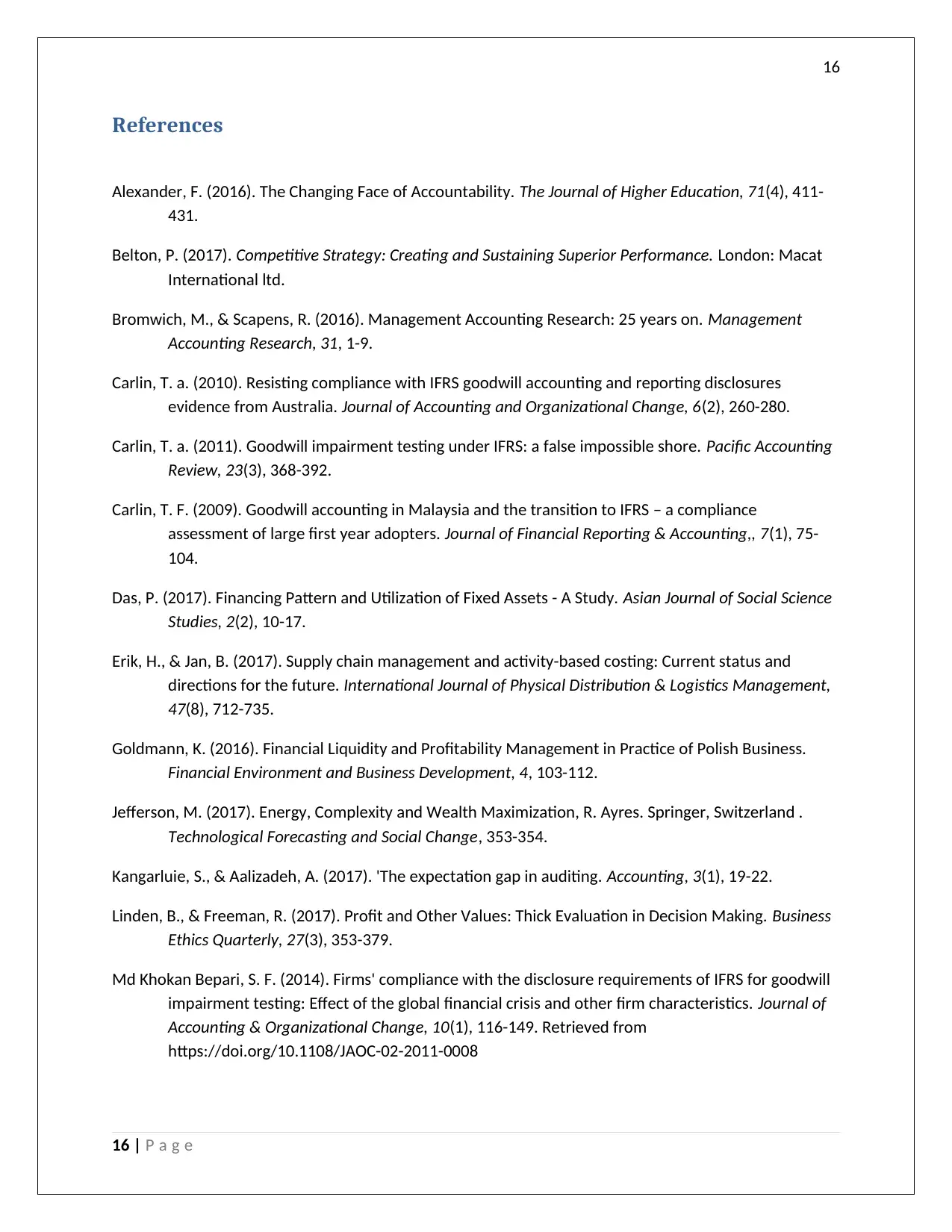
16
References
Alexander, F. (2016). The Changing Face of Accountability. The Journal of Higher Education, 71(4), 411-
431.
Belton, P. (2017). Competitive Strategy: Creating and Sustaining Superior Performance. London: Macat
International ltd.
Bromwich, M., & Scapens, R. (2016). Management Accounting Research: 25 years on. Management
Accounting Research, 31, 1-9.
Carlin, T. a. (2010). Resisting compliance with IFRS goodwill accounting and reporting disclosures
evidence from Australia. Journal of Accounting and Organizational Change, 6(2), 260-280.
Carlin, T. a. (2011). Goodwill impairment testing under IFRS: a false impossible shore. Pacific Accounting
Review, 23(3), 368-392.
Carlin, T. F. (2009). Goodwill accounting in Malaysia and the transition to IFRS – a compliance
assessment of large first year adopters. Journal of Financial Reporting & Accounting,, 7(1), 75-
104.
Das, P. (2017). Financing Pattern and Utilization of Fixed Assets - A Study. Asian Journal of Social Science
Studies, 2(2), 10-17.
Erik, H., & Jan, B. (2017). Supply chain management and activity-based costing: Current status and
directions for the future. International Journal of Physical Distribution & Logistics Management,
47(8), 712-735.
Goldmann, K. (2016). Financial Liquidity and Profitability Management in Practice of Polish Business.
Financial Environment and Business Development, 4, 103-112.
Jefferson, M. (2017). Energy, Complexity and Wealth Maximization, R. Ayres. Springer, Switzerland .
Technological Forecasting and Social Change, 353-354.
Kangarluie, S., & Aalizadeh, A. (2017). 'The expectation gap in auditing. Accounting, 3(1), 19-22.
Linden, B., & Freeman, R. (2017). Profit and Other Values: Thick Evaluation in Decision Making. Business
Ethics Quarterly, 27(3), 353-379.
Md Khokan Bepari, S. F. (2014). Firms' compliance with the disclosure requirements of IFRS for goodwill
impairment testing: Effect of the global financial crisis and other firm characteristics. Journal of
Accounting & Organizational Change, 10(1), 116-149. Retrieved from
https://doi.org/10.1108/JAOC-02-2011-0008
16 | P a g e
References
Alexander, F. (2016). The Changing Face of Accountability. The Journal of Higher Education, 71(4), 411-
431.
Belton, P. (2017). Competitive Strategy: Creating and Sustaining Superior Performance. London: Macat
International ltd.
Bromwich, M., & Scapens, R. (2016). Management Accounting Research: 25 years on. Management
Accounting Research, 31, 1-9.
Carlin, T. a. (2010). Resisting compliance with IFRS goodwill accounting and reporting disclosures
evidence from Australia. Journal of Accounting and Organizational Change, 6(2), 260-280.
Carlin, T. a. (2011). Goodwill impairment testing under IFRS: a false impossible shore. Pacific Accounting
Review, 23(3), 368-392.
Carlin, T. F. (2009). Goodwill accounting in Malaysia and the transition to IFRS – a compliance
assessment of large first year adopters. Journal of Financial Reporting & Accounting,, 7(1), 75-
104.
Das, P. (2017). Financing Pattern and Utilization of Fixed Assets - A Study. Asian Journal of Social Science
Studies, 2(2), 10-17.
Erik, H., & Jan, B. (2017). Supply chain management and activity-based costing: Current status and
directions for the future. International Journal of Physical Distribution & Logistics Management,
47(8), 712-735.
Goldmann, K. (2016). Financial Liquidity and Profitability Management in Practice of Polish Business.
Financial Environment and Business Development, 4, 103-112.
Jefferson, M. (2017). Energy, Complexity and Wealth Maximization, R. Ayres. Springer, Switzerland .
Technological Forecasting and Social Change, 353-354.
Kangarluie, S., & Aalizadeh, A. (2017). 'The expectation gap in auditing. Accounting, 3(1), 19-22.
Linden, B., & Freeman, R. (2017). Profit and Other Values: Thick Evaluation in Decision Making. Business
Ethics Quarterly, 27(3), 353-379.
Md Khokan Bepari, S. F. (2014). Firms' compliance with the disclosure requirements of IFRS for goodwill
impairment testing: Effect of the global financial crisis and other firm characteristics. Journal of
Accounting & Organizational Change, 10(1), 116-149. Retrieved from
https://doi.org/10.1108/JAOC-02-2011-0008
16 | P a g e
1 out of 17
Related Documents
Your All-in-One AI-Powered Toolkit for Academic Success.
+13062052269
info@desklib.com
Available 24*7 on WhatsApp / Email
![[object Object]](/_next/static/media/star-bottom.7253800d.svg)
Unlock your academic potential
© 2024 | Zucol Services PVT LTD | All rights reserved.





